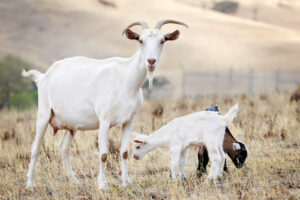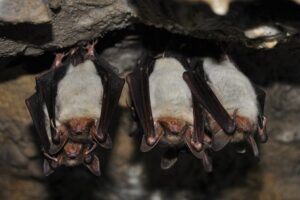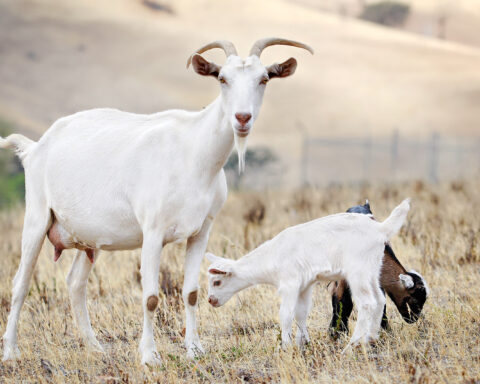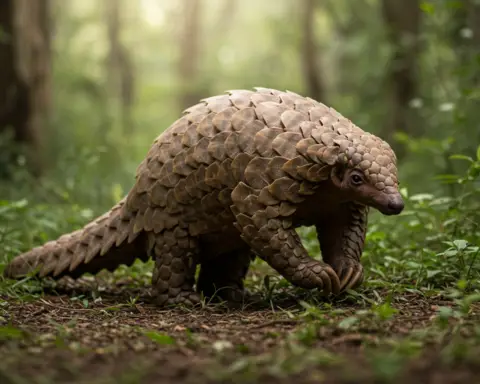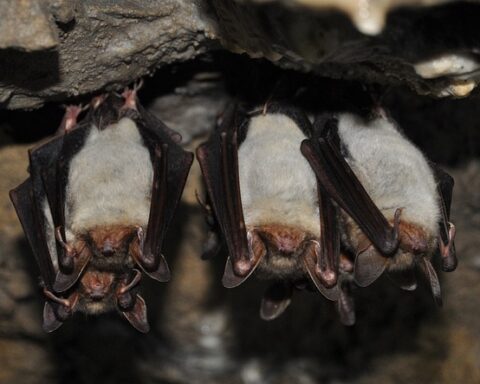Cane rats are robust rodents with stocky bodies, small ears, and short tails; body covered with sharply pointed, but pliable, spiny hairs; broad, heavily built orange-colored chisel-shaped incisors, with the upper ones grooved longitudinally at the front. They will make habitats in grasslands and wooded savanna.
What Do Cane Rats Look Like?
- Except for size and mass, there is a great similarity in the external features between the two cane rat species.
- The description here concentrates mainly on the greater cane rat for which more information is available. They are heavily built with a head that looks small for the body, including small ears and a squarely cut muzzle. The muzzle is used as a pad when they butt each other.
- When panicking in captivity, they will also ram the walls of the enclosure with the muzzle. The body is covered with spiny hairs that are firm, sharply pointed yet supple, and varies in color from a speckled yellowish brown to a speckled grayish brown.
- The lips, chin, and throat are predominately white, with a brown pellage mottled with white on the ventral surface. The skin is very weak and tears easily, however, it also heals easily.
- The dark-brown tail tapers and is covered with short, bristly hair. When caught by the tail, it can easily be broken off.
- In adults, the genital area is an orange color. The legs are strong, the feet well padded. The front feet have five digits, the first one being rudimentary and the fifth one small.
- The hind feet have four larger digits, the first one being absent and the fifth one small. All the available digits are strong and possess strong, powerful, and fairly straight claws.
- Cane rats are the second largest rodents in Africa, surpassed in size and mass only by the porcupine Hystrix africae australis (26.4–28.6 lb; 12–13 kg).
- Cane rat males are much larger than females. The greater cane rat is about twice the size of the lesser cane rat.
- The two upper and two lower incisor teeth are broad, heavily built, and chisel shaped.
- The bright orange enamel layer covers only the incisors on the front, while the rest is dentine.
- The upper incisors are deeply grooved longitudinally on the outer surface. Regardless of the enormous incisors, there is no record of people being bitten by wild cane rats when handling them.
- They will rather make frantic efforts to escape, a process in which they may injure themselves badly.
What Do Cane Rats Eat?
They are vegetarian and eat the roots, shoots, and stems of various grasses. They cut the grass stems at the base with their powerful incisors, and then while sitting in an upright position, they manipulate the grass stem or other foodstuff with their front paws while pushing it into the mouth and chopping it into small pieces with the incisors.
Grasses are their principal food, including elephant grass, Pennisetum purpureum, and buffalo or guinea grass, Panicum maximum. They consume the soft parts of the grasses and shrubs, and the drier sections and leaves are often discarded.
They can become severe agricultural pests in some areas where crops, such as peanuts, maize, sorghum, wheat, cassava, and sugar cane grow in close proximity to their habitat.
They are very fond of kikuyu grass and will raid lawns. They scratch the soil aside to expose vegetables such as potatoes and sweet potatoes or, in certain grasses, to expose the succulent underground stems or roots.
Fermentation of food occurs mainly in the caecum and the animals are coprophagous. They produce two kinds of feces, hard pellets that are excreted and soft pellets that are reingested.
Where Do Cane Rats Live?
The greater cane rat is much more widespread in Africa than the lesser cane rat, and although there are overlaps in their distribution, they occupy different ecological niches. They occur in grassland or in wooded savanna areas of Africa south of the Sahara. Because of specialized habitat requirements, their distribution is discontinuous.
They do not inhabit rainforest, arid regions, or deserts. The only exception being forests where there are clearings with a grassland invasion. Cane rats (or “grasscutters” as they are known in West Africa) can be found in virtually all countries of west, east, and southern Africa, as far south as the eastern Cape, South Africa.
Cane Rat Habitat
Cane rats can be found in swampy low-lying areas along river banks and streams where there are reed beds or areas of dense tall grass, as well as the higher altitudes on the eastern tropical escarpment where they are able to utilize drier terrain. They are good swimmers and will easily take to the water when threatened.
How Do Cane Rats Behave in the Wild?
Cane rats are predominantly nocturnal in the wild and travel through trails in the reeds and grass. They appear to live in small groups of up to 12 animals. In captivity, greater cane rats exist as family groups of one male and from one to seven females. The dominant male will not tolerate the presence of another mature male.
The same behavior is anticipated in the wild where a family group will consist of a dominant male, few females, and their offspring. When alarmed, they stamp their hind feet on the ground, making a booming sound.
They also make a loud whistling sound, as a stress or warning sound. When relaxed and eating, they make soft grunting noises. In the reed beds or grass runs, waste products of feeding and scattered piles of feces can be found.
Although they have well-developed claws, they do not appear to burrow. Where there appears to be a lack of cover, they make use of existing holes, dug by other animals or caused by water erosion alongside river banks.
How Do Cane Rats Reproduce?
In captivity, cane rats are polygynous and the same is expected for the wild. The gestation period is 156 days (range is 137–172 days). It is possible for them to have two litters per annum, with litter sizes ranging from one to five young and even eight.
Newborn young are precocial, meaning fully furred with open eyes. Mass at birth varies from 2.7 to 7.2 oz (75–204 g).
Three pairs of teats are situated high on the sides of the abdomen, and females suckle their young while standing or lying on their bellies.
The young are weaned at about four weeks. They stay with the parents until about five months when they become sexually mature.
At this age, in captivity, the dominant male starts showing aggressive behavior towards the young males.
Dominant young males also show aggressive behavior towards their brothers. Young females are not bothered. Cane rats produce throughout the year although birth peaks occur at certain times of the year, presumably during rainy seasons when more food is available.
In captivity, birth can occur any time males and females are placed together.

